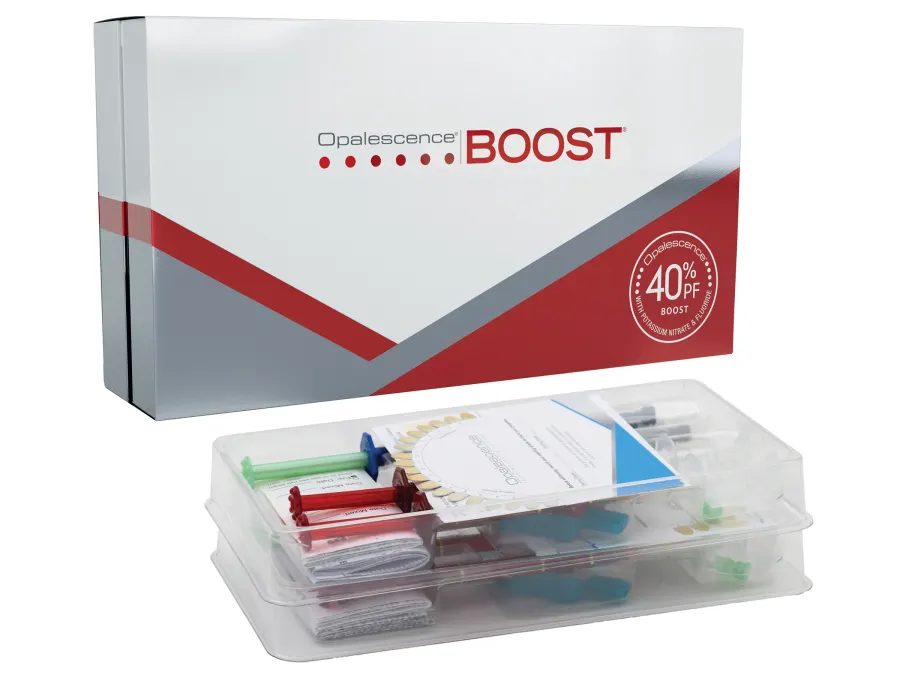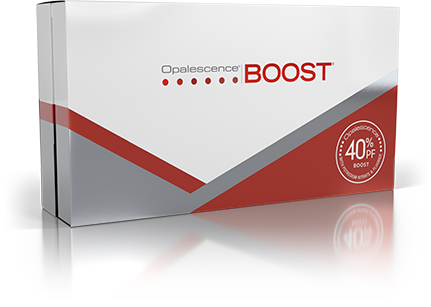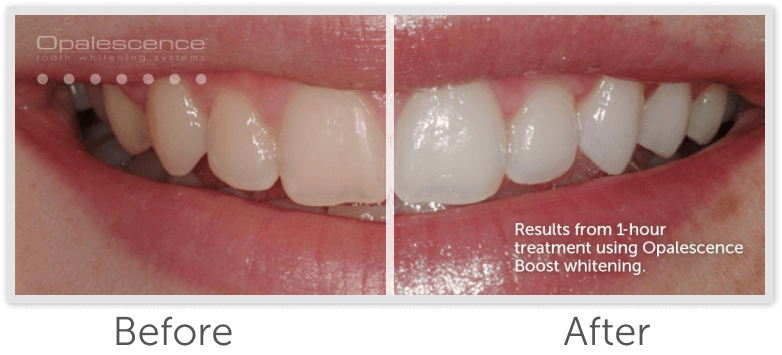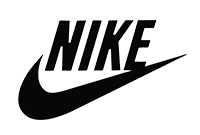Opalescence Boost in-office power whitener is a chemically activated gel that provides brighter, whiter teeth after about an hour in the dental chair. The powerful 40% hydrogen peroxide gel is chemically activated, so it doesn’t require a hot, uncomfortable light to work. Using the unique double-syringe configuration, the clinician activates the 40% hydrogen peroxide formula just prior to application, ensuring every dose of Opalescence Boost whitening is fresh and effective.
- Chemically activated, so no light is needed
- Powerful 40% hydrogen peroxide gel
- Opalescence tooth whitening gel contains PF (potassium nitrate and fluoride)
- Fresh chemical for each application
- Precise delivery
- Easy to see for complete removal
- Two to three 20-minute applications
- Thicker formula prevents the gel from running
- No refrigeration required prior to mixing
- Use with Black Mini™ Tip
- Vegan—no animal products
- Certified gluten free
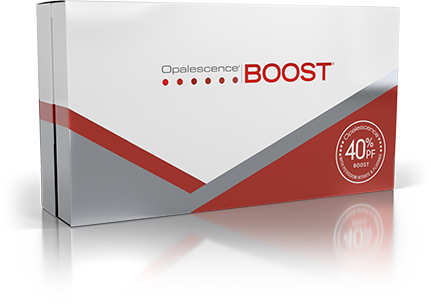
Professional Teeth Whitening With Immediate Results
Award-winning Opalescence Boost in-office teeth whitening gel is the best way to whiten teeth quickly. With just two or three 20-minute treatments its powerful 40% hydrogen peroxide formula provides instantly noticeable results. It is perfect for patients who want to get whiter teeth fast, who have particularly difficult stains to remove, or who have an important event around the corner that requires a bright, white smile.
Trust the experts. With over 30 years of experience, more than 50 teeth whitening awards earned, and over 100 million smiles brightened, Opalescence teeth whitening is the #1 professional teeth whitening brand on the planet.

The Best Way to Whiten Teeth Fast
Some in-office whitening procedures rely on lights or lasers to “activate” the chemical whitening agent. However, Opalescence Boost in-office whitening relies solely on chemical activation. Studies have confirmed that the whitening agent is effective without any lasers1.
Opalescence Boost teeth whitening gel’s innovative double-syringe mixing configuration ensures fresh teeth whitening gel for each application. Because the gel is chemically activated, no refrigeration is required prior to mixing.
After it is mixed, Opalescence Boost teeth whitening gel is conveniently applied using a Black Mini™ tip. Its thick viscosity formula prevents the gel from running, and its noticeable red color makes it easily visible to aid in precise placement and complete removal. Opalescence Boost whitening gel is also formulated with at least 20% water content, which helps prevent dehydration—maximizing patient comfort and satisfaction.
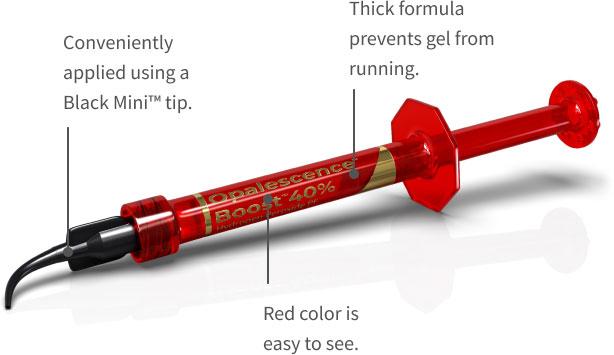
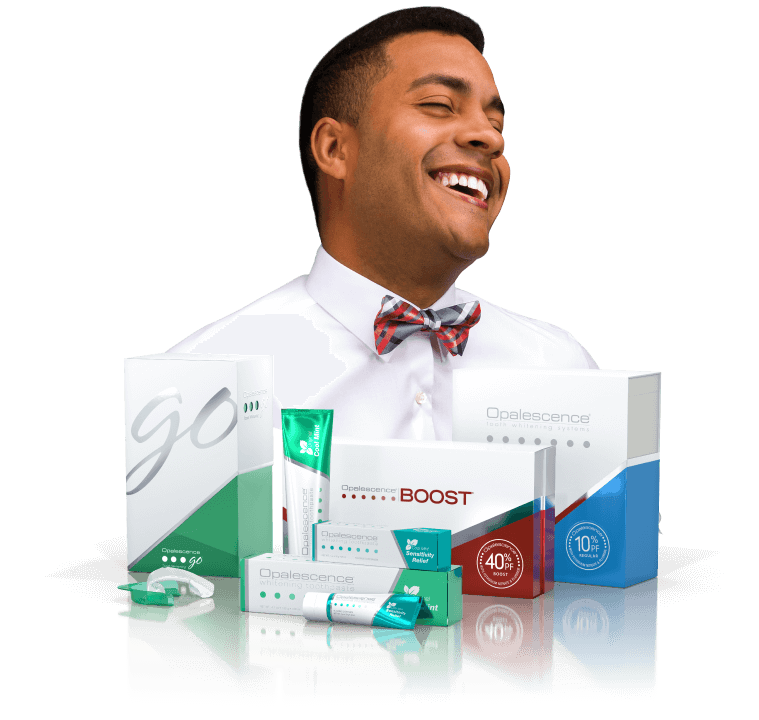
Create an At-Home Teeth Whitening Kit for Your Patients
While each Opalescence teeth whitening kit is effective as a stand-alone
teeth whitening treatment, many patients benefit from using a
combination of products to meet their needs. Because each Opalescence
teeth whitening product works in combination with the others, it is easy
to create a customized teeth whitening kit for any patient to take
home. For example, Opalescence Go teeth whitening trays are a great way
to follow-up an Opalescence™ Boost™ in-office whitening treatment and go
perfectly with the daily use of Opalescence™ Whitening Toothpaste. A 1
oz. tube of Opalescence Whitening Toothpaste is included with each
Opalescence Go whitening patient kit.
Technical Details
Unmatched Quality
The names Opalescence teeth whitening and Ultradent are synonymous with quality. All of our research and development is done in-house. So is our manufacturing and quality control. This allows us to guide and oversee the entire process from the time an Opalescence whitening innovation is conceived to the time it s created and packaged for shipping. We have met the strictest standards, and our facility is FDA registered and ISO 13485 certified. All of this ensures every product performs exactly as it s supposed to for you and for your patients.
No Refrigeration Required Prior To Mixing
Refrigeration is not required to
store Opalescence Boost teeth whitening gel prior to mixing. If
refrigerated, ensure that the chemistries are brought to room
temperature before mixing them and activating the gel. After the gel is
activated, any remaining product must be refrigerated.
Superior Stability
Opalescence teeth whitening products are among the most stable whitening products in the industry, each maintaining virtually all of its effectiveness over the course of its shelf life. Because delivery times vary depending on the location of each particular dental office, Opalescence whitening products are formulated with transit time in mind. Although shelf life is ultimately dependent on how each product is stored, our teeth whiteners will remain stable even after being shipped across the country2.
Vegan and Certified Gluten Free
Opalescence Boost whitening gel is vegan, meaning no animal products
are used. It is also certified gluten free by the Gluten Intolerance
Group of North America (GFCO)—an independent, third-party certification
program for gluten-free products. This means it fits in with the
lifestyles and beliefs of patients from diverse backgrounds.
Made in the USA from Globally Sourced Materials
Opalescence teeth whitening gels, trays, syringes, and toothpastes are manufactured at Ultradent’s facility in Utah from globally sourced materials. By purchasing products manufactured in the USA, you are supporting our nation’s economy and helping to provide jobs to hundreds of Americans who take pride in what they do.
Contains PF
Opalescence teeth whitening gel
contains PF (potassium nitrate and fluoride) for patient comfort.
Clinicals
Before and After Opalescence Boost Whitening
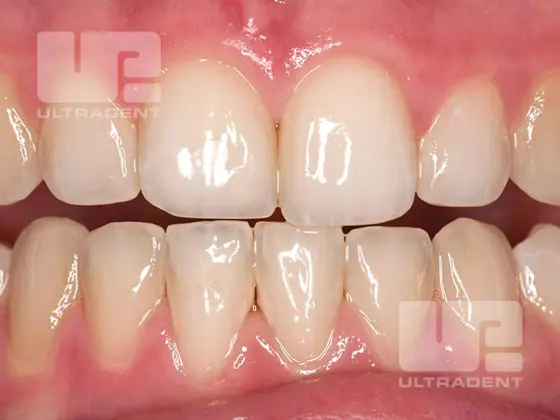
Before Opalescence Boost whitening.
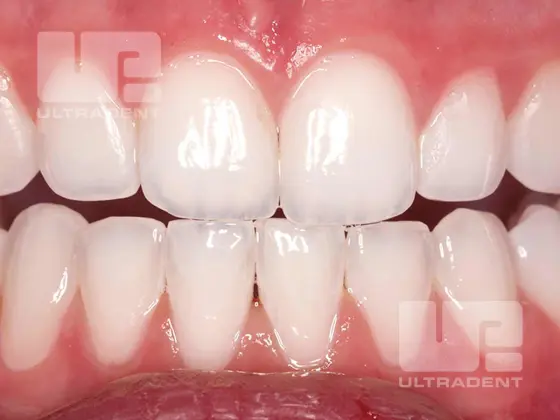
After three applications, each lasting 20 minutes, over one session.
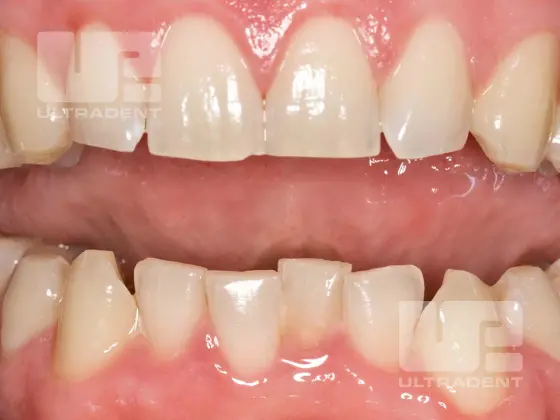
Before Opalescence Boost whitening.
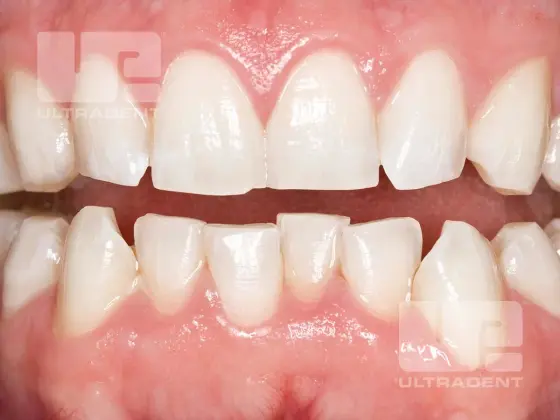
After six applications, each lasting 15 minutes, over two sessions.

Before Opalescence Boost whitening.
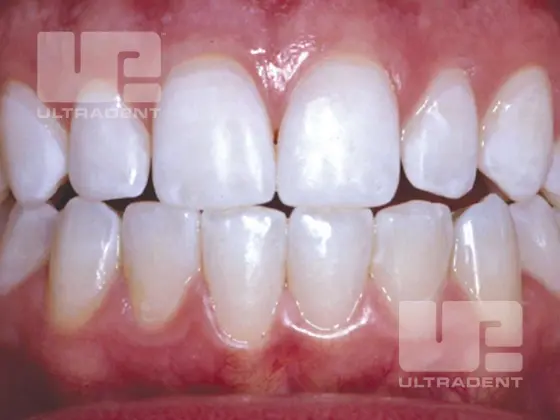
After six applications, each lasting 15 minutes, over two sessions.
Videos
Procedures
Opalescence Boost Whitening Procedure
See Instructions for Use for complete instructions, warnings, and precautions.
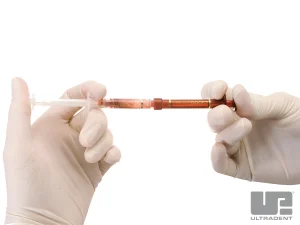
Step 1
Place protective eyeware and clothing on yourself and the patient to
prevent contact with whitening agent. Check to see that the syringes are
securely attached before mixing. To mix, follow the instructions on the
reverse side.
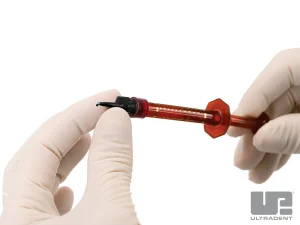
Step 2
Press all mixed gel into the RED syringe. Separate the two syringes and attach the Black Mini™ tip or other recommended tip onto the red syringe. Check the flow on a cotton gauze or pad prior to applying it intraorally. If resistance is met, replace the tip and recheck the flow.
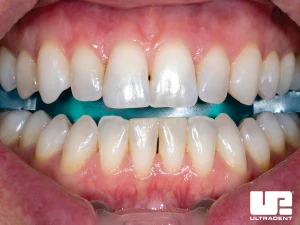
Step 3
Place Ultradent IsoBlock™ bite block and self-supporting plastic cheek retractors. Completely rinse and air dry teeth and gingiva.
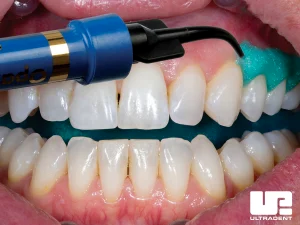
Step 4
Securely attach a Black Mini tip to OpalDam™ Green resin barrier and check flow. Express a continuous bead along the gingival margin, overlapping approximately 0.5 mm onto the enamel. Begin and finish the bead one tooth beyond the most distal tooth that is being whitened. Express the resin through any open embrasures.
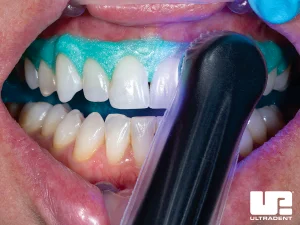
Step 5
Light cure the OpalDam
Green resin barrier for 20 seconds per arch using a scanning motion.
Check the resin cure with an instrument using caution not to disrupt the
seal.
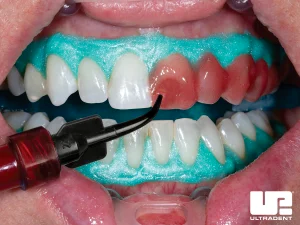
Step 6
Apply a 0.5–1.0 mm thick layer of gel to the labial surface of the teeth. Allow the gel to remain on the teeth for 20 minutes per application.
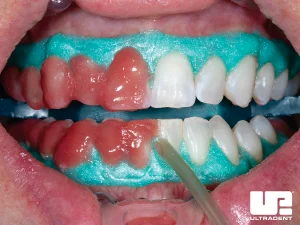
Step 7
Suction gel from teeth using the Ultradent™ Luer Vacuum Adapter and SST™ tip or a surgical suction tip. Do not use water. Repeat steps 6–7. Stop when desired results are achieved, or if the three applications per visit maximum has been met.
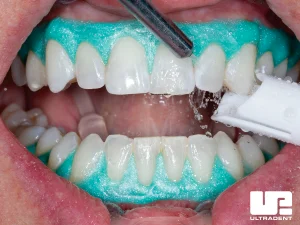
Step 8
After the final application is complete and all visible gel is removed, thoroughly rinse teeth with an air/water spray and the high volume suction.
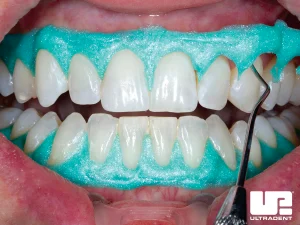
Step 9
Gently slide the tip of a dental instrument beneath the OpalDam resin barrier and lift it off. Check for and remove any interproximal remnants.
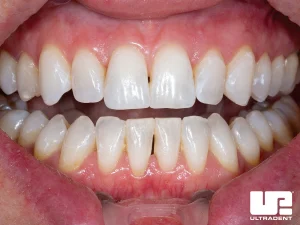
Step 10
Evaluate the shade change. If additional whitening is desired and no significant sensitivity is noted, reschedule the patient in 3–5 days for repeat treatment or dispense take-home whitening treatment.
Testimonials
Dr. Dimple Kotwani – Opalescence Boost Whitening — Tooth Whitening Patients Love
Dr. Brian Palmer – Opalescence Boost
Dr. Mikel Hopkins – Opalescence Boost
Dr. Steve Glassman – Opalescence Boost
Dr. Paul Nielson – Opalescence Boost: Simple, Straightforward, Effective
“We love brightening smiles with Opalescence Boost. It does a better job than the other in-office whitening systems we’ve used. It’s easy to use, and patients rave about the results.”
Julia Ellis, Office Manager – Hopewell, VA
Frequently Asked Questions
Opalescence whitening gels contain an active whitening ingredient—either carbamide peroxide or hydrogen peroxide. Peroxide gels break down into water, oxygen, and reactive oxygen molecules. These reactive oxygen molecules treat both the enamel and the dentin, oxidizing the bonds of discolored stain molecules. By changing the stained molecules, the tooth becomes lighter.
Reactive oxygen molecules permeate the entire tooth, so there is no need for the whitening agent to be in contact with every surface of the tooth for the entire tooth to be whitened.
Because the reactive oxygen needs to dissipate from the tooth before
bonding, it is necessary to wait 7–10 days before any bonding procedure.
Teeth whitening results are very stable, but depending on the patient’s
nutrition and lifestyle habits, the procedure may need to be redone
periodically. Due to the safety of the teeth whitening agents, this
should not concern the dentist or patient.
Tooth sensitivity can occur as a result of whitening. If sensitivity
occurs, it is transient and disappears after the completion of whitening
treatments. If desensitizing treatments are desired, we recommend the
use of UltraEZ™ desensitizing gel or Enamelast™ fluoride varnish. Opalescence™ Whitening Toothpaste Sensitivity Formula can also be used to help to prevent or lessen sensitivity if it occurs.
Research & Studies
Carbamide peroxide whitening of nonvital single discolored teeth: case reports.
Caughman WF, Frazier KB, Haywood VB. Carbamide peroxide whitening of nonvital single discolored teeth: case reports.
http://www.ncbi.nlm.nih.gov/pubmed/10356567 – Caughman WF, Frazier KB, Haywood VB.
In-office “power” bleaching of vital teeth as an adjunct to at-home bleaching.
Morgan J, Presley S. In-office “power” bleaching of vital teeth as an adjunct to at-home bleaching. Advanced Tooth Whitening, a Comprehensive Guide to Whitening. Prac Perio & Aesthet Dent. 2002;14(suppl 2):16-23.
http://www.tecnoimportdental.cl/referencias/archivos/literatura/2002morgan.pdf –
Morgan J, Presley S.
External bleaching therapy with activation by heat, light or laser—a systematic review.
Buchalla W, Attin T. External bleaching therapy with activation by heat, light or laser—a systematic review. Dent Mater. 2007;23(5):586-96.
http://www.ncbi.nlm.nih.gov/pubmed/16820199 – Buchalla W, Attin T.
In-office vital tooth bleaching—what do lights add?
Hein DK, Ploeger BJ, Hartup JK, Wagstaff RS, Palmer TM, Hansen LD. In-office vital tooth bleaching—what do lights add? Compend Contin Educ Dent. 2003;24(4A):340-52.
http://www.ncbi.nlm.nih.gov/pubmed/12793211 – Hein DK, Ploeger BJ, Hartup JK, Wagstaff RS, Palmer TM, Hansen LD.
PDFThe effect of tooth bleaching on substance P expression in human dental pulp.
Caviedes-Bucheli J, Ariza-García G, Restrepo-Méndez S, Ríos-Osorio N, Lombana N, Muñoz HR. The effect of tooth bleaching on substance P expression in human dental pulp. J Endod. 2008;34(12):1462-5.
http://www.ncbi.nlm.nih.gov/pubmed/19026874 – Caviedes-Bucheli J, Ariza-García G, Restrepo-Méndez S, Ríos-Osorio N, Lombana N, Muñoz HR.
PDFClinical evaluation of chemical and light-activated tooth whitening systems.
Kugel G, Papathanasiou A, Williams AJ 3rd, Anderson C, Ferreira S. Clinical evaluation of chemical and light-activated tooth whitening systems. Compend Contin Educ. 2006;27(1)54-62.
http://www.ncbi.nlm.nih.gov/pubmed/16454016 – Kugel G, Papathanasiou A, Williams AJ 3rd, Anderson C, Ferreira S.
PDFIn vitro efficacy and risk for adverse effects of light-assisted tooth bleaching.
Bruzell EM, Johnsen B, Aalerud TN, Dahl JE, Christensen T. In vitro efficacy and risk for adverse effects of light-assisted tooth bleaching. Photochem Photobiol Sci. 2009;8(3):377-85.
http://www.ncbi.nlm.nih.gov/pubmed/19255679 –
Bruzell EM, Johnsen B, Aalerud TN, Dahl JE, Christensen T. Photochem.
New bleaching considerations compared with at-home bleaching.
Haywood, V. New bleaching considerations compared with at-home bleaching. J Esthet Restor Dent. 2003;15(3):184-7.
http://www.researchgate.net/publication/10663385_New_bleaching_considerations_compared_with_at-home_bleaching –
Haywood, V.
Colorimetric assessment of laser and home bleaching techniques.
Jones AH, Diaz-Arnold AM, Vargas MA, Cobb DS. Colorimetric assessment of laser and home bleaching techniques. J Esthet Dent. 1999;11(2):87-94.
http://www.ncbi.nlm.nih.gov/pubmed/10530271 –
Jones AH, Diaz-Arnold AM, Vargas MA, Cobb DS.



